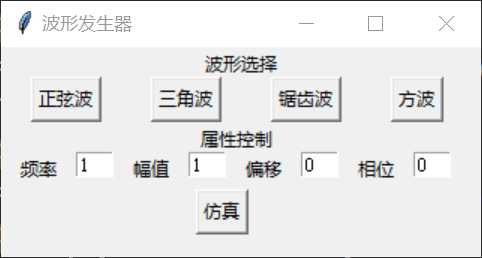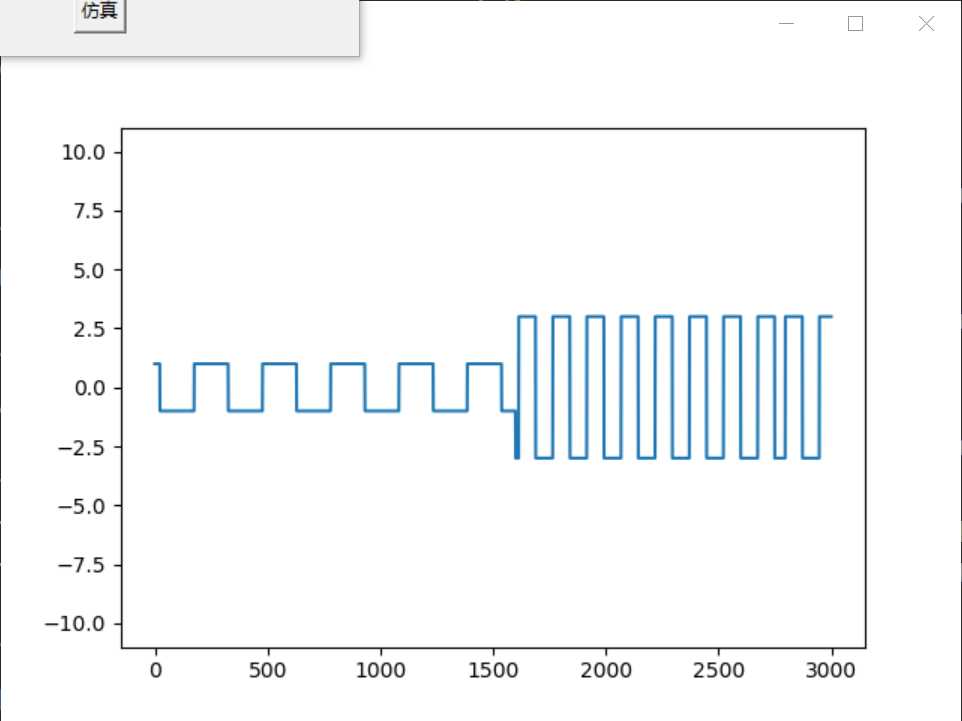最近学校又抽风把我自动化系的苦逼童鞋留下做课设,简直无聊到爆的-->用VB实现函数发生器,(语言不限制)
大伙不知从哪搞来的MATLAB版本,于是几十个人就在这基础上修修改改蒙混过关了,可我实在不想用MATLAB
写(要是被抓了,几十个人0分,那场面->。->),用VB? 又要学一门语言。。况且我不太习惯她的编码方式,于是
乎想起了我一直在玩的python,
# ------------------------先上代码---(由于只是应付课设,在编码规范和代码逻辑上没有做优化,只是实现功能)---------
import numpy as np
import matplotlib.pyplot as plt
import matplotlib.animation as animation
import tkinter
from tkinter import messagebox
freq = 1
margin = 1
deviation = 0
wave = 0
ss = []
fig = plt.figure()
axes1 = fig.add_subplot(111)
line, = axes1.plot(np.linspace(-10,10,3000))
def fangbo(data):
lis = []
for i in list(data):
if i//5%2 == 1:
lis.append(1)
else:
lis.append(-1)
return np.array(lis)
def juchi(data):
lis = []
for i in list(data):
lis.append(i%5/2.5)
return np.array(lis)-1
def sanjiao(data):
lis = []
for i in list(data):
if i//5%2 == 1:
lis.append(i%5/2.5)
else:
lis.append((5-i%5)/2.5)
return np.array(lis)-1
def update(data):
line.set_ydata(data)
return line,
def data_gen():
i = 50
res = [0*i for i in range(3000)]
while True:
global freq, margin, deviation, wave, ss
if wave == 0:
lis = list(margin*np.sin(freq*3.1415926/5*np.linspace(1,100,3000))+deviation)
elif wave == 1:
lis = list(margin*juchi(freq*np.linspace(1,100,3000))+deviation)
elif wave == 2:
lis = list(margin*sanjiao(freq*np.linspace(1,100,3000))+deviation)
elif wave == 3:
lis = list(margin*fangbo(freq*np.linspace(1,100,3000))+deviation)
ss = ss+lis[i-50:i]
yield ss+res[len(ss):]
i = i+50
if len(ss) >= 3000:
ss = ss[50:]
if i > 3050:
i = 50
def ssin():
global wave
wave = 0
def jjc():
global wave
wave = 1
def ssj():
global wave
wave = 2
def ffb():
global wave
wave = 3
def simu():
global freq, margin, deviation
try:
fe1 = float(fe.get(‘0.0‘,‘end‘))
me1 = float(me.get(‘0.0‘,‘end‘))
de1 = float(de.get(‘0.0‘,‘end‘))
xe1 = float(xe.get(‘0.0‘,‘end‘))
except:
messagebox.showinfo(title=‘错误‘,message=‘属性值必须为浮点数‘)
else:
freq = fe1
margin = me1
deviation = de1
if __name__ == ‘__main__‘:
root = tkinter.Tk()
root.title(‘波形发生器‘)
root.maxsize(320,140)
root.minsize(320,140)
lb = tkinter.Label(root,text=‘波形选择‘)
lb.pack()
fbt = tkinter.Button(root,text=‘正弦波‘,command=ssin)
fbt.place(x=20,y=20)
sbt = tkinter.Button(root,text=‘三角波‘,command=ssj)
sbt.place(x=100,y=20)
jbt = tkinter.Button(root,text=‘锯齿波‘,command=jjc)
jbt.place(x=180,y=20)
jbt = tkinter.Button(root,text=‘方波‘,command=ffb)
jbt.place(x=260,y=20)
ib = tkinter.Label(root,text=‘属性控制‘)
ib.place(x=130,y=50)
fl = tkinter.Label(root,text=‘频率‘)
fl.place(x=10,y=70)
fe = tkinter.Text(root,width=3,height=1)
fe.insert(‘end‘,‘1‘)
fe.place(x=50,y=70)
ml = tkinter.Label(root,text=‘幅值‘)
ml.place(x=85,y=70)
me = tkinter.Text(root,width=3,height=1)
me.insert(‘end‘,‘1‘)
me.place(x=125,y=70)
dl = tkinter.Label(root,text=‘偏移‘)
dl.place(x=160,y=70)
de = tkinter.Text(root,width=3,height=1)
de.insert(‘end‘,‘0‘)
de.place(x=200,y=70)
xl = tkinter.Label(root,text=‘相位‘)
xl.place(x=235,y=70)
xe = tkinter.Text(root,width=3,height=1)
xe.insert(‘end‘,‘0‘)
xe.place(x=275,y=70)
mb = tkinter.Button(root,text=‘仿真‘,command=simu)
mb.place(x=130,y=95)
ani = animation.FuncAnimation(fig, update, data_gen, interval=10)
plt.show()
root.mainloop()
# -------------------------------结果如下--------------------------------------------------------------


